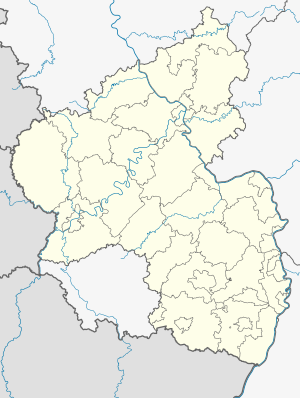Schützenkanzel tunnel
| Schützenkanzel tunnel | ||
|---|---|---|
| use | Railway tunnel | |
| traffic connection | Kaiserslautern – Enkenbach railway line | |
| place | Enkenbach-Alsenborn | |
| length | 57 m | |
| Number of tubes | 1 | |
| construction | ||
| Client | Society of the Palatinate Northern Railways | |
| business | ||
| release | May 15, 1875 | |
| location | ||
|
|
||
| Coordinates | ||
| West portal | 49 ° 28 ′ 51 ″ N , 7 ° 53 ′ 32 ″ E | |
| East portal | 49 ° 28 ′ 51 ″ N , 7 ° 53 ′ 35 ″ E | |
The Schützenkanzel tunnel is the only railway tunnel along the Kaiserslautern – Enkenbach line . In addition, it is the second shortest of its kind within the Palatinate after the copper smelting tunnel along the neighboring Alsenz Valley Railway .
location
The Schützenkanzel tunnel is located in the northern Palatinate Forest between its sub-areas Diemersteiner Wald , Sembacher Platten and Otterberger Wald, directly on the southern edge of the settlement of Enkenbach . It crosses under the local birch road and a field path to the Birkenhof , both of which lead into a wooded area. It is named after the Schützenkanzel located in the middle of the Enkenbach settlement area , on which a street called An der Schützenkanzel is located not far from the tunnel .
history
Already in 1863 a memorandum was used to advertise a railway from Kaiserslautern via Kirchheimbolanden to the connection to the Rhine-Hessian border in Alzey. A route from Kaiserslautern via Enkenbach was designed for the first time, during which a watershed was to be pierced by a tunnel shortly before Enkenbach. However, since they feared negative effects on the operation and above all the income of the Palatinate Ludwig Railway, a realization was initially abandoned .
Despite the fact that a connecting curve to the Hochspeyer station had been built with the Alsenz Valley Railway , which was built in 1870 and 1871 and designed as a transit route, taking into account the interests of Kaiserslautern , the Barbarossastadt found this route to be a detour. The plans for the Zellertalbahn to Monsheim and the Donnersbergbahn via Kirchheimbolanden to Alzey , which are now beginning, brought the original concept of the connecting route between Enkenbach station and Kaiserslautern station to life. The watershed between Eselsbach and Klosterbach had to be overcome in the south-western area of the town of Enkenbach by means of an incision and a short tunnel. On May 15, 1875, the line including the Schützenkanzel tunnel was opened. Passenger traffic was initially set on May 29, 1987. Finally, on June 1, 1997, it was reactivated.
Web links
Individual evidence
- ↑ Memorandum on the construction of a railway from Kaiserslautern via Kirchheimbolanden to connect to the state border, Kirchheimbolanden in June 1863, Bavarian State Library, signature 4 BAVAR 550 dn
- ↑ Heinz Sturm: The Palatinate Railways (= publications of the Palatinate Society for the Advancement of Science . Volume 53 ). pro MESSAGE, Ludwigshafen am Rhein 2005, ISBN 3-934845-26-6 , p. 208 .
- ↑ Wolfgang Fiegenbaum, Wolfgang Klee: Farewell to the rail. Disused railway lines from 1980 to 1990 . 1997, p. 421 .
- ↑ Wolfgang Fiegenbaum, Wolfgang Klee: Return to Rail - Reactivated and New Lines in Passenger Traffic 1980-2001 . 2001, p. 178 .
